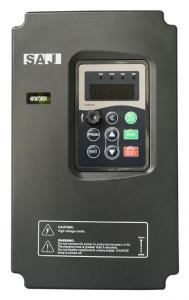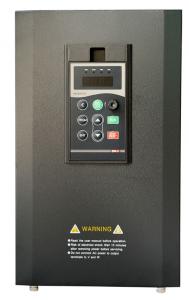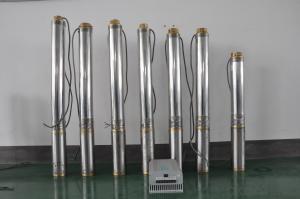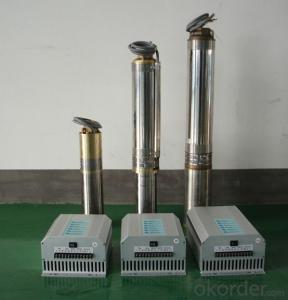Solar Pump Controller suitable for different area
- Loading Port:
- Guangzhou
- Payment Terms:
- TT OR LC
- Min Order Qty:
- 1 watt
- Supply Capability:
- 1000 watt/month
OKorder Service Pledge
OKorder Financial Service
You Might Also Like
Advantages of SAJ solar pumping system
■ The system can carry out independent power supply and solve the water problem in off-grid regions.
■ MPPT function of solar inverter is excellent in tracing the maximum power point with high reliability and quick response.
■ The system is environmentally friendly without storage battery.
■ Intelligent IGBT modules of high performance inside can make the conversion efficiency up to 98% and above.
■ Users can select the function of water-level detecting to prevent the system from overflow and dry extraction.
Applications:
Barren Mountain Water Supply, Environment Improvement, Meadow Water Supply, Reducing Water Loss, Life Water Supply and so on.
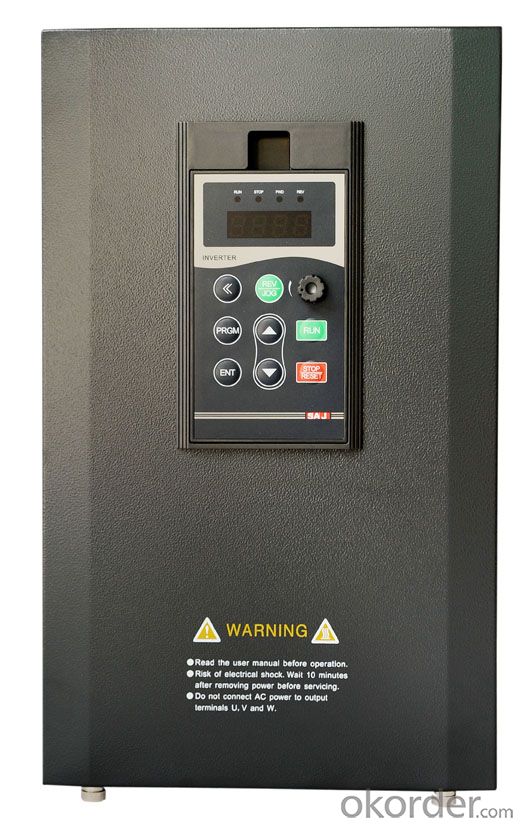
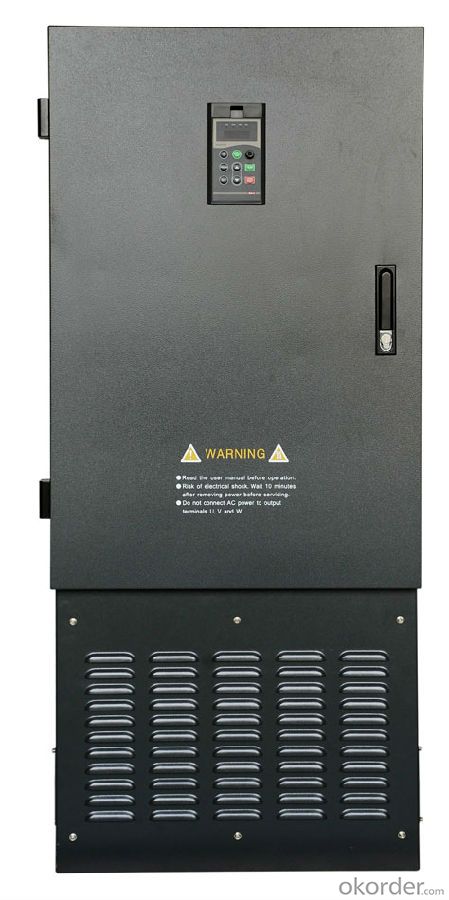
FAQ
1. How long will my inquiry get response?
Your inquiry related to our products or prices will be replied within 24 hours.
2. Can I get professional service and suggestion?
Well-trained and experienced staffs to answer all your questions in fluent English.
3. Do you accept OEM or customized design?
OEM & ODM, any your customized lightings we can help you to design and put into product.
4. What if I need specific design?
Distributorship are offered for your unique design and some our current models.
- Q:How do I ensure the safety of the electrical components in a solar pump system?
- To ensure the safety of the electrical components in a solar pump system, there are a few key steps you can follow: 1. Proper Installation: Ensure that the system is installed by a qualified professional who follows the manufacturer's guidelines and local electrical codes. This will help prevent any potential hazards or malfunctions. 2. Regular Maintenance: Regularly inspect and maintain the electrical components of the system, including checking for loose connections, damaged wires, and signs of wear. Promptly address any issues to prevent further damage or safety risks. 3. Grounding: Ensure that the system is properly grounded to protect against electrical shock and short-circuits. Proper grounding helps to redirect electrical currents in the event of a fault or lightning strike. 4. Surge Protection: Install surge protection devices to safeguard the system from power surges caused by lightning or electrical fluctuations. Surge protectors can minimize the risk of damage to the electrical components. 5. Monitoring and Protection: Utilize monitoring systems and protective devices like circuit breakers or fuses to detect and prevent overloads, short circuits, or other electrical faults that could pose a safety risk. 6. Knowledge and Training: Educate yourself and any users of the system about basic electrical safety precautions, such as avoiding contact with live components, understanding warning signs, and knowing how to shut down the system in an emergency. By following these precautions and regularly maintaining the system, you can help ensure the safety of the electrical components in a solar pump system.
- Q:What is the maximum depth that a solar pump can operate?
- The maximum depth that a solar pump can operate depends on various factors such as the power of the solar panels, the efficiency of the pump, and the specific model being used. However, on average, solar pumps can typically operate at depths of up to 100-200 feet.
- Q:Can a solar pump be used in areas with limited access to reliable internet or communication networks for monitoring?
- Yes, a solar pump can be used in areas with limited access to reliable internet or communication networks for monitoring. Solar pumps are typically designed to function independently, utilizing energy from the sun to power the pump. While monitoring systems may rely on internet or communication networks for real-time data collection, a solar pump can still operate effectively without these features. However, in such cases, monitoring and maintenance of the pump may need to be conducted manually or through alternative means, such as periodic site visits.
- Q:Can a solar pump be used in areas with high water demand?
- Yes, a solar pump can be used in areas with high water demand. Solar pumps are capable of pumping large volumes of water and can be designed to meet the specific water requirements of an area. Additionally, solar pumps can be combined with storage systems to ensure a continuous water supply, making them suitable for areas with high water demand.
- Q:How does a solar pump help in reducing electricity bills?
- A solar pump reduces electricity bills by utilizing the energy from the sun to power the pump, eliminating the need for grid electricity. This renewable energy source is free and abundant, allowing users to save on their electricity costs.
- Q:What is the required maintenance for the pump controller?
- The required maintenance for a pump controller typically includes regular inspections, cleaning, and testing to ensure its optimal performance and longevity. Here are some key maintenance tasks for a pump controller: 1. Inspection: Regularly inspect the pump controller for any visible signs of damage, such as loose connections, worn-out wires, or corrosion. This will help identify any issues that need to be addressed promptly. 2. Cleaning: Keep the pump controller clean by removing any accumulated dirt, dust, or debris. Use a soft cloth or brush to gently clean the exterior and ensure proper ventilation. Avoid using harsh chemicals or abrasive materials that could damage the controller. 3. Testing: Periodically test the pump controller to verify its functionality. This can involve checking the control panel, switches, and buttons to ensure they are operating correctly. Additionally, test the pump controller's communication capabilities, such as remote monitoring or data logging, if applicable. 4. Electrical Checks: Inspect the wiring and electrical components of the pump controller to ensure they are secure and functioning properly. Look for any signs of overheating, loose connections, or frayed wires that could pose a safety hazard or affect the pump's performance. 5. Software Updates: If the pump controller utilizes software or firmware, regularly check for updates provided by the manufacturer. Keeping the software up to date can improve the controller's performance, add new features, and address any known bugs or vulnerabilities. 6. Calibration: Depending on the application, some pump controllers may require periodic calibration to maintain accurate measurement and control of flow rates, pressure, or other parameters. Consult the manufacturer's guidelines or recommendations for specific calibration procedures. 7. Lubrication: If applicable, ensure that any moving parts within the pump controller are properly lubricated. Follow the manufacturer's instructions regarding the type of lubricant to use and the recommended intervals for reapplication. Remember to always follow the manufacturer's guidelines and recommendations for the specific pump controller model. Regular maintenance will help prolong the pump controller's lifespan, improve its efficiency, and minimize the risk of unexpected failures.
- Q:Can solar pumps be used for water supply in religious institutions or temples?
- Yes, solar pumps can be used for water supply in religious institutions or temples. Solar pumps are a sustainable and cost-effective solution that can provide a reliable source of water without the need for electricity or fuel. They can be installed in remote areas where grid power is not available, making them an ideal choice for religious institutions or temples located in such regions. Additionally, solar pumps align with the principles of sustainability and can help reduce the carbon footprint of these institutions.
- Q:How does the altitude or elevation affect the performance of a solar pump?
- The altitude or elevation affects the performance of a solar pump primarily due to the changes in atmospheric pressure. As one goes higher in altitude, the atmospheric pressure decreases, which in turn affects the pump's ability to generate suction and lift water. At higher altitudes, the pump may experience reduced efficiency and lower water output. Additionally, lower atmospheric pressure can also impact the efficiency of the solar panels used to power the pump, leading to decreased power generation. Therefore, it is important to consider and adjust for the altitude or elevation when designing and installing a solar pump system.
- Q:How big of a solar panel is required for a solar pump?
- The size of a solar panel required for a solar pump depends on factors such as the power requirements of the pump, the amount of sunlight available, and the efficiency of the solar panel. It is recommended to consult with a solar energy professional or the manufacturer of the solar pump to determine the appropriate size of solar panel needed for optimal performance.
- Q:Can a solar pump be used for water supply in off-grid homes or cabins?
- Yes, a solar pump can certainly be used for water supply in off-grid homes or cabins. Solar pumps use solar energy to power the pumping mechanism, eliminating the need for electricity from the grid. This makes them an ideal solution for remote locations where access to electricity is limited or non-existent. Solar pumps can be used to extract water from wells, boreholes, or other water sources and provide a reliable and sustainable water supply. They are cost-effective, environmentally friendly, and require minimal maintenance. Additionally, solar pumps can be combined with storage systems to ensure a constant water supply even during periods of low sunlight. Overall, using a solar pump for water supply in off-grid homes or cabins offers a practical and efficient solution that aligns with sustainable and self-sufficient living.
1. Manufacturer Overview |
|
|---|---|
| Location | |
| Year Established | |
| Annual Output Value | |
| Main Markets | |
| Company Certifications | |
2. Manufacturer Certificates |
|
|---|---|
| a) Certification Name | |
| Range | |
| Reference | |
| Validity Period | |
3. Manufacturer Capability |
|
|---|---|
| a)Trade Capacity | |
| Nearest Port | |
| Export Percentage | |
| No.of Employees in Trade Department | |
| Language Spoken: | |
| b)Factory Information | |
| Factory Size: | |
| No. of Production Lines | |
| Contract Manufacturing | |
| Product Price Range | |
Send your message to us
Solar Pump Controller suitable for different area
- Loading Port:
- Guangzhou
- Payment Terms:
- TT OR LC
- Min Order Qty:
- 1 watt
- Supply Capability:
- 1000 watt/month
OKorder Service Pledge
OKorder Financial Service
Similar products
New products
Hot products
Related keywords
